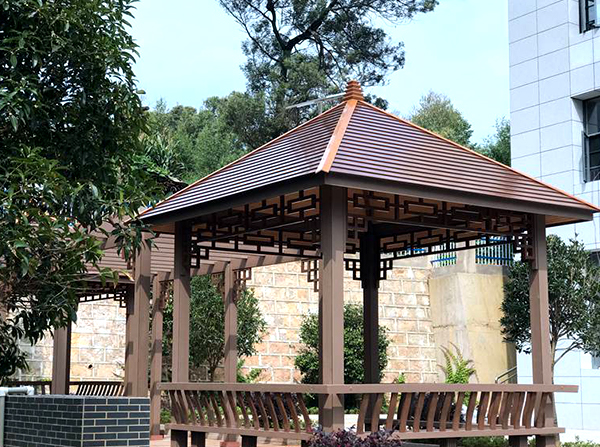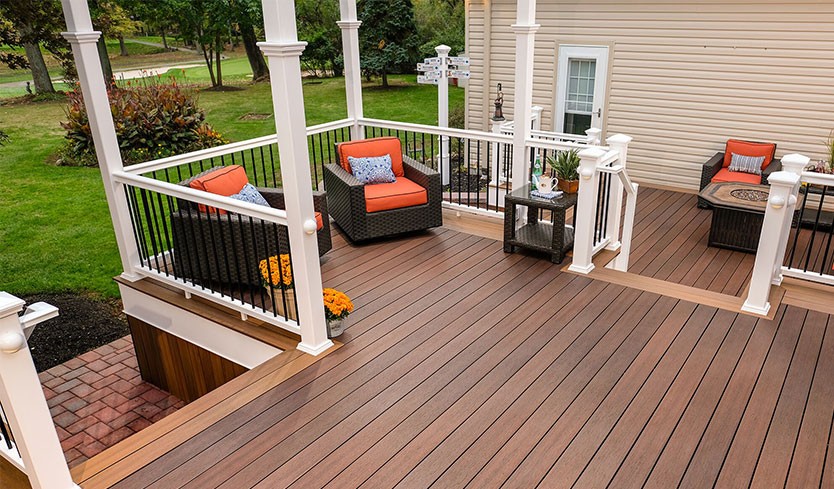Garden and DIY Garden Decoration and Landscaping Decking:
Imagine standing on your own deck, garden or landscaped terrace, with a cup of aromatic coffee in your hand, looking out over the distant landscape. What a wonderful picture it is! However, decking needs to be chosen carefully, if you are not careful, the exposed landscaping decking will be damaged or even corroded under natural erosion. If you do not want decking to affect your good mood when you look at the scenery, then please continue to read the following article.
Table of Contents
Common Decking Materials and Their Characteristics
Solid wood decking
Solid wood decking is loved by many for its natural texture and beautiful appearance. It can add a natural touch to your garden or landscape decking. However, solid wood decking has some drawbacks to be aware of. Firstly, it is susceptible to moisture, warping, and rotting and requires regular maintenance and care. Secondly, solid wood decking is relatively expensive and may not be suitable for families on a budget.
Aluminum Decking
Aluminum decking is another common decking material. It is resistant to corrosion and weathering, and is able to hold up well in outdoor environments for long periods of time. In addition, aluminum decking has the advantage of being lightweight and easy to install. However, aluminum decking is more expensive and heavier than other materials, which may make it less suitable for scenarios that require frequent handling.
WPC Decking
WPC (Wood Plastic Composite) decking is a decking material that has become increasingly popular in recent years. It combines the advantages of wood and plastic and is waterproof, corrosion-resistant, and weather-resistant while retaining the natural beauty of wood. Compared to solid wood and aluminum decking, WPC decking has more prominent advantages. Firstly, it has better durability and corrosion resistance, and is able to stay in good condition for a long time in outdoor environments. Secondly, WPC decking is relatively easy to install and maintain and does not require regular application of preservatives or paints like solid wood. In addition, WPC decking has better anti-slip properties, which increases safety when used.

Comparing three decking materials
When choosing decking materials, we need to consider their durability, aesthetics, ease of installation, and price. By comparing the three materials, solid wood, aluminum, and WPC, we can see that WPC decking excels in these aspects. Firstly, WPC decking has better durability and corrosion resistance and is able to stay in good condition for a long time in outdoor environments. Secondly, it is relatively easy to install and maintain and does not require regular application of preservatives or paints like solid wood. In addition, WPC decking has better anti-slip properties, increasing safety when in use. Finally, compared with solid wood and aluminum decking, WPC decking is more affordable and lighter in weight.
Application of WPC decking in garden and landscape design
Choosing the right decking material for garden or landscape design is crucial; WPC decking has the natural beauty of wood decking and is suitable for outdoor environments that are not easy to break, making it the first choice of many designers. Whether it is used as a recreational area or a viewing platform, WPC decking can add a unique charm to your garden. In addition, thanks to its excellent weather and corrosion resistance, WPC decking is able to withstand rain, sun, wind and snow for a long service life.
WPC Decking DIY installation tutorials and advantages
Preparation
Cleaning the ground
Before you start installing WPC Decking, you must make sure that the ground in the installation area is level. If the ground is uneven, it will not only affect the aesthetics of the WPC floor but may also lead to a sense of instability when walking and may even cause damage to the floor. Therefore, leveling treatment is required for uneven floors. Cement mortar or other leveling materials can be used to fill in the low spots to ensure that the entire floor is on the same level. In addition, the ground must be kept dry, as a humid environment may cause the WPC floor to swell with moisture or become moldy. It is also very important to clear the floor of debris; any small stones, dust or other foreign objects may affect the installation and longevity of the floor.

Measurement
Before purchasing a WPC floor, you need to accurately measure the size and shape of the room. This includes the length, width, and any irregular areas that may exist (e.g., posts, corners, etc.). By taking measurements, you can calculate the area of WPC flooring needed so that you can avoid buying too much or too little material. This will not only help save money but also ensure a smooth installation process. When taking measurements, professional measuring tools such as a tape measure or laser range finder should be used to ensure the accuracy of the data.
Preparation Tools
In order to successfully complete the installation of WPC flooring, you need to prepare a series of necessary tools. These tools include but are not limited to, a saw (for cutting the WPC flooring), a drill (for drilling holes to allow for the installation of fixings), a screwdriver (for tightening the screws to secure the flooring), and a ruler (for accurate measurements and markings). In addition to these basic tools, you may also need some auxiliary tools such as a level (to ensure that the flooring is installed level), a pencil (to mark the cut lines), and gloves (to protect your hands from injury). When preparing your tools, make sure that all tools are in good condition, sharp, and easy to handle, as this will greatly improve the efficiency and safety of the installation.

Assembling the frame
Assembly steps
Assemble the cut WPC flooring according to the design drawings. First, determine the starting point and direction of the floor, and then sequentially splice the floor together. In the splicing process, pay attention to the size of the gap between the floors and try to keep it consistent to avoid subsequent unevenness. At the same time, use screws or glue to fix the floor together to ensure a strong and reliable connection. Auxiliary tools, such as clamps or supports, can be used to help keep the floor stable during the assembly process.
Inspection and Adjustment
After assembly is complete, the entire frame structure needs to be carefully checked to ensure that it is firm and reliable. Its stability can be tested by gently shaking the floor or stepping hard on it. If any loose or unstable areas are found, they need to be adjusted and reinforced in time. It is also necessary to check whether the flatness of the floor surface and the overall effect meet the design requirements. If necessary, fine-tuning or reassembling part of the floor can be carried out. In the inspection process, special attention should be paid to whether the joints between the floor are flat and free of height difference to ensure the aesthetics of the whole floor and the comfort of use.
Fixed structure
Positioning and marking
Before placing the assembled frame structure in its intended location, its exact position needs to be determined and marked. This helps ensure the accuracy and aesthetics of the flooring installation. Tools such as rulers and levels can be used to determine the centerline or edgeline of the floor and mark it on the ground. Parameters such as the height and slope of the flooring also need to be determined based on the design drawings and the actual conditions. During the marking process, make sure that the markings are clearly visible and cannot be easily erased or covered.
Fixing the floor
After placing the assembled frame structure in the predetermined position, it is necessary to use a screwdriver to fix the connecting parts to the foundation. In the process of fixing, pay attention to the right degree of tightness of the screws to avoid too tight to cause deformation or damage to the floor; at the same time, also to avoid too loose to cause the floor to loosen or unstable. When fixing the floor, you can also use some auxiliary tools such as supports or clamps to help maintain the stability and accuracy of the floor. After the fixing is completed, the whole structure needs to be checked again to see if it is solid and reliable and to make the necessary adjustments and reinforcements.

After introducing the advantages of WPC decking I would like to recommend a WPC decking manufacturer located in China–HOSUNG Company. As a professional WPC decking manufacturer, HOSUNG is committed to providing customers with high-quality products and services. They have advanced production equipment and a technical team to ensure that the quality and performance of their products are at the leading edge of the industry. Whether for home use or commercial projects, HOSUNG’s WPC decking can meet your needs. Not only do their products have excellent weather and corrosion resistance, but they also have the ability to withstand harsh weather conditions and maintain a long service life. In addition, HOSUNG also focuses on environmental protection and uses recyclable materials to produce WPC decking, contributing to the sustainable development of the planet.
Choosing the right decking material for your garden is a crucial step in creating a beautiful garden, and WPC decking is becoming more and more popular because of its durability, aesthetics and ease of installation. And HOSUNG, as a reliable manufacturer of WPC decking, will provide you with quality products and services. Let’s enjoy the beauty of outdoor life together!








